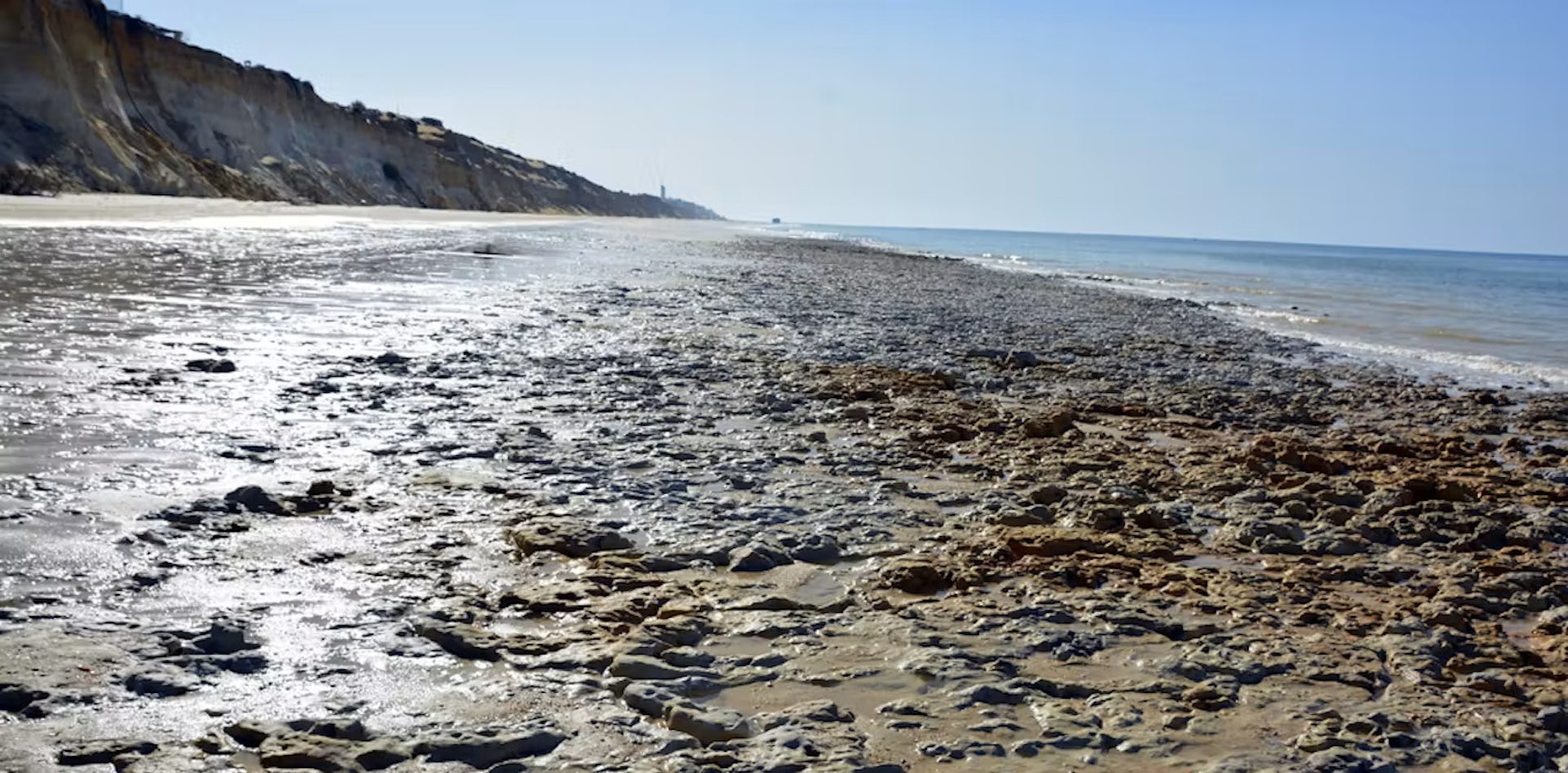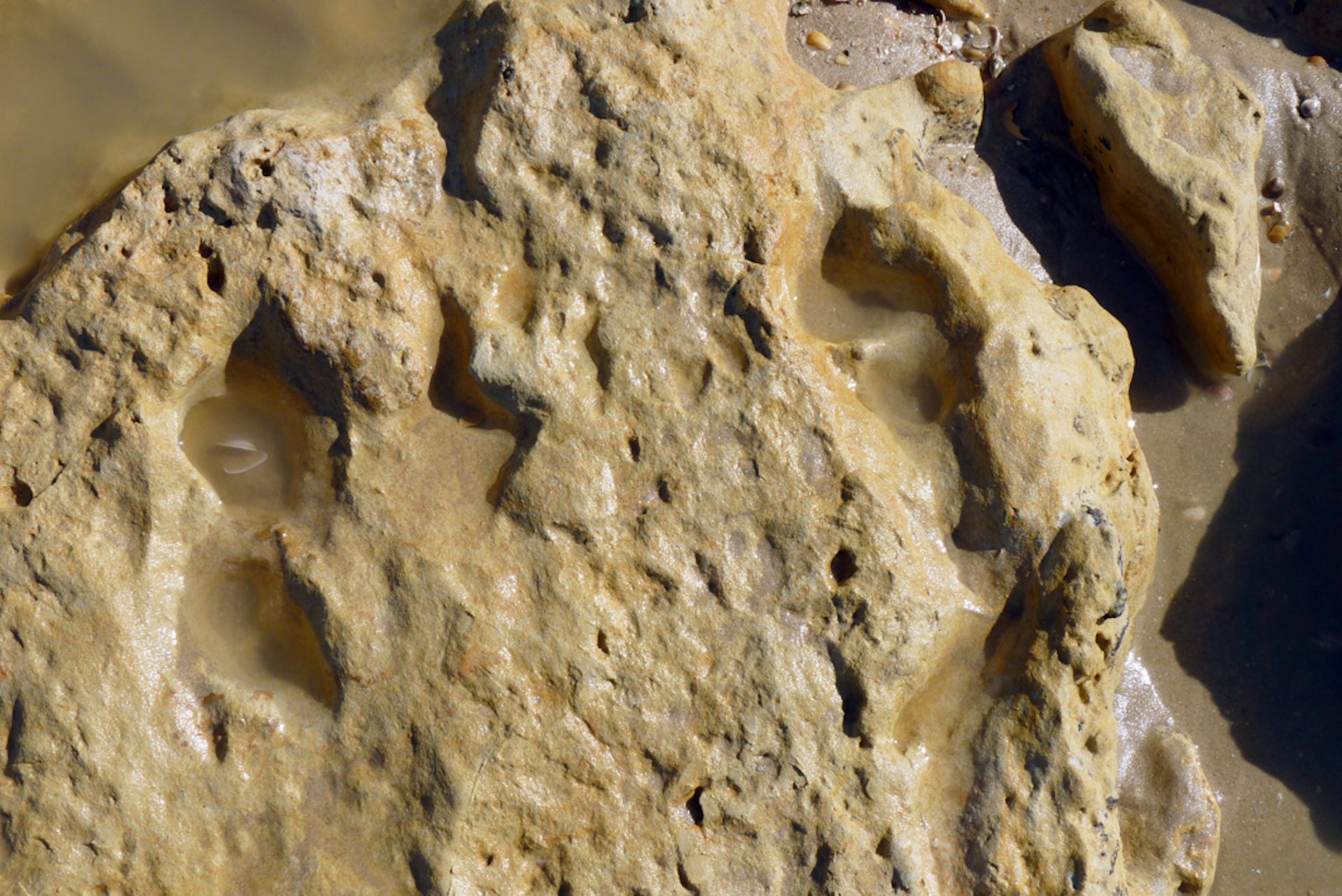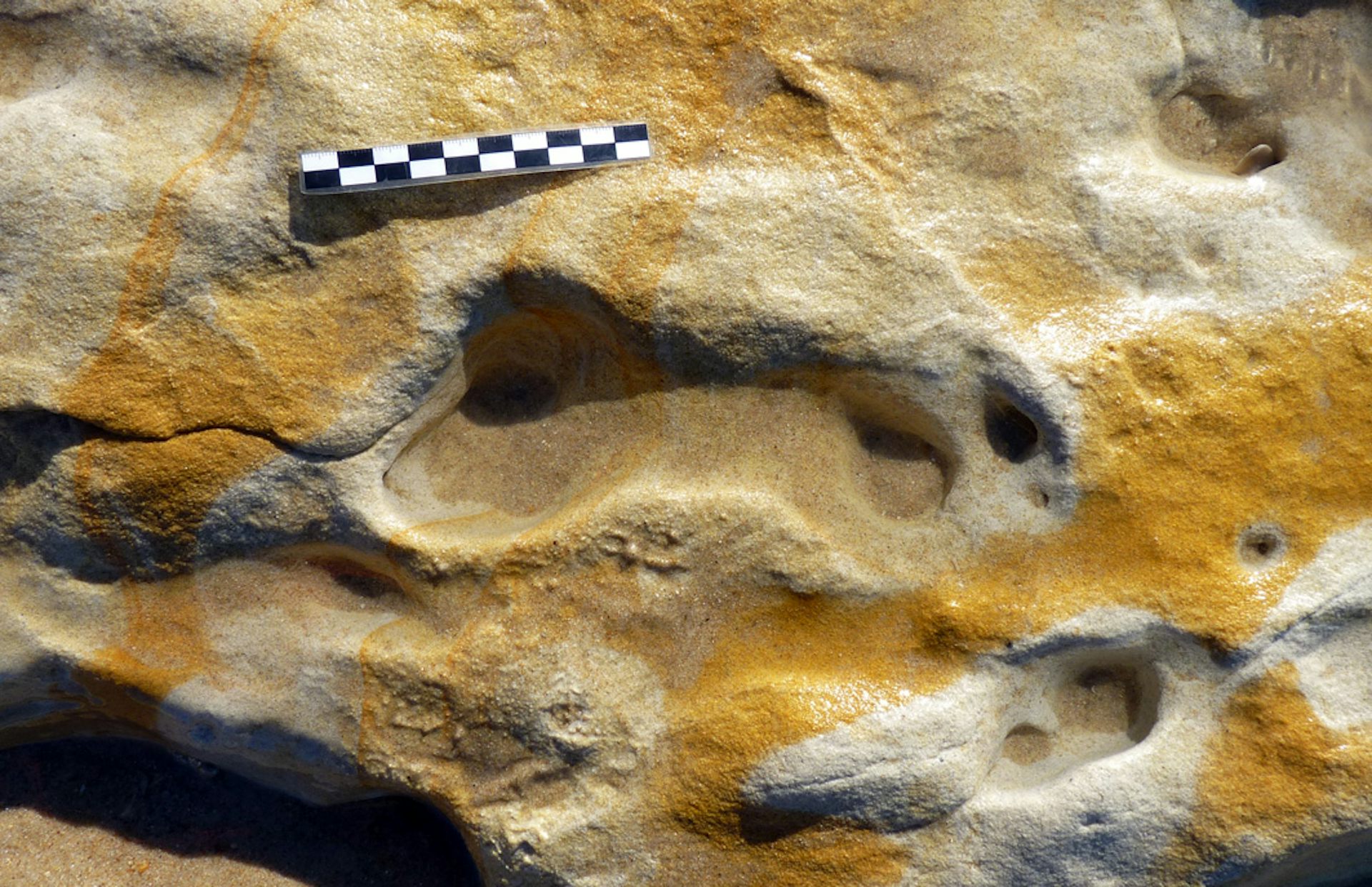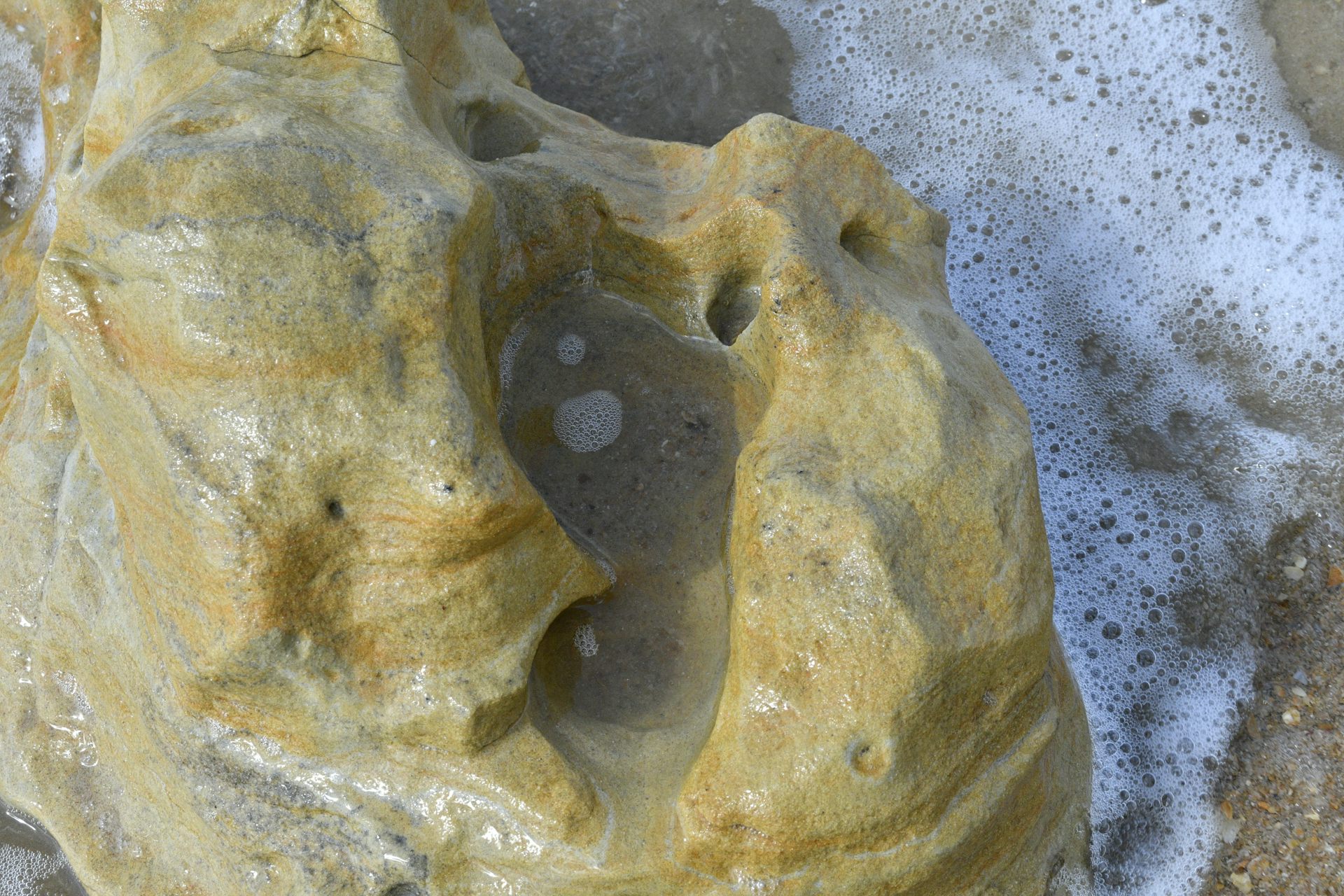
Homo heidelbergensis (The Broken Hill skull)
One of the suspect species
One of the suspect species
The Natural History Museum, London, UK
When first discovered the footprints at Matalascañas, Huelva , Southwest Spain, were dated to around 106,000 ± 19,000 years based on a previous study to determine the age of the Asperillo cliff.
Embarrassing though even that relatively recent dating is for Creationists, the team have now revised the date of the footprints by dating the surface in which they were made, using a technique called Optically Stimulated Luminescence, which basically measures when the surface was last exposed to sunlight before being buried for a prolonged period. This gave a date of 295,800 ± 17,000 years.
The significance of this new date is that rather than being made by Neanderthals from the Upper Pleistocene as was first thought, these tracks were made by ancestor of the Neanderthals, or early Neanderthals from the Middle Pleistocene, during a period known to geologists as the transition from Marine Isotope Stage 9 (MIS-9) to MIS-8 when there was a sudden cooling then warming of the climate in the Iberian Peninsula.
The authors have published their revised findings, open access, in the journal Scientific Reports and written an article in The Conversation. That article is reprinted below under a Creative Commons license, reformatted for stylistic consistency. The original article can be read here:

Recently found ‘Neanderthal footprints’ in the South of Spain could be 275,000 years old

General view of the site with hominid footprints on the beach of Matalascañas, Huelva (Spain).
Credit: E. Mayoral, Author provided
Eduardo Mayoral Alfaro, Universidad de Huelva; Ana Santos, Universidad de Oviedo; Antonio Rodríguez Ramírez, Universidad de Huelva; Asier Gomez-Olivencia, Universidad del País Vasco / Euskal Herriko Unibertsitatea; Ignacio Díaz-Martínez, Universidad Nacional de Rio Negro; Jérémy Duveau, Muséum national d’histoire naturelle (MNHN); Jorge Rivera Silva, Universidad de Sevilla; Juan Antonio Morales, Universidad de Huelva, and Ricardo Díaz-Delgado, Estación Biológica de Doñana (EBD-CSIC)
A little over a year ago we reported on a large area at the foot of the Asperillo cliff, on the coast of the Doñana Natural Area in Huelva, Spain. There, along with numerous animal footprints, other footprints had been found – those of hominids.
Until then, the only time reference that allowed the age of the site to be established was the dating of one of the dunes that covered the surface to around 106,000 years ago (Upper Pleistocene). As with most of the hominid footprints found worldwide, we dated them in line with the environment in which they were found. For this reason, our first hypothesis when trying to attribute the new found footprints was that they belonged to Neanderthals, who lived in the Upper Pleistocene.
However, in the course of the investigation, we sampled the surface where the footprints were found, which had never been dated before, and the dunes above. It turned out to be about 295,800 years old (Middle Pleistocene): this is to say, much earlier than previously thought.
Drastic climate change
The new dating placed the footprints in a new geographical and environmental context. The European continent was about to undergo drastic climate change 300,000 years ago. Relatively warm conditions were changing to much colder conditions, a precursor to a an ice age. At that time, the sea level on the European continent was on average about 60 metres below its present level, which implies that the Huelva coastline would be 20 to 25 kilometres offshore from its present position.
In other words, the coastal plain was very extensive and probably created by the delta of the river. It was probably covered by water during the wet seasons and totally or partially exposed during the dry seasons.
Over this shallow and saline lake environment, made of polygonal ground and microbial covers, that hominids and other fauna trampled. Today, the same kind of polygonal covers are found in extensive areas of marshland in both hot desert and tropical climates.
More or less extensive vegetated areas would be found in the non-flooded areas of this wide coastal plain. Around them, there would be a significant development of dune systems that would move landward from the coast.
New suspects?

Credit: E. Mayoral, Author provided




General view of the site at Matalascañas beach, Huelva, and various hominid footprints discovered there.
Credit: E. Mayoral, Author provided
Hominid fossils belonging to the Middle Pleistocene are thought to be from the Neanderthal lineage: Homo neanderthalensis and Homo heidelbergensis. However, their remains are still very scarce, fragmentary and geographically dispersed. Worse still, footprints are even scarcer than skeletal remains. In the entire European Middle Pleistocene, only four sites have provided traces from this period: Terra Amata, in France (380,000 years old), Roccamonfina, in Italy (345,000 years old, attributed to Homo heidelbergensis), Biache-Vaast, in France (236,000 years old, Homo neanderthalensis) and Theopetra, in Greece (130,000 years old, Homo neanderthalensis).
On the other hand, it must be considered that the formal characteristics of the footprint are not only the result of the anatomy of the foot, but also of other factors such as biomechanical characteristics, the type of substrate and the processes that gave rise to the fossil. Therefore, the footprints studied must be well preserved and reflect several anatomical features (arch impression of the toes), which is rarely the case in places like this site in Huelva.
To confirm which hominid group the footprints belong to, we would need to compare their anatomical characteristics with the known skeletal record for the Middle Pleistocene.
Almost all the foot fossils known for this period come from the Sima de Los Huesos site (Atapuerca, Spain) and are associated with individuals related to Neanderthals. Making a more precise attribution would be difficult, as there are many debates about the evolution of this lineage, but also about the taxonomic definition of Homo heidelbergensis.
Different models for the evolution of the Neanderthal lineage have been proposed, but this question is still far from being resolved, given the paucity of the fossil record and the new and more complicated evolutionary picture provided by the latest ancient DNA studies. Moreover, not all anatomical traits evolved at the same rate and polymorphisms probably occurred in different traits at different rates of occurrence.
Despite these uncertainties, the Doñana site proves to be a crucial record for understanding human occupations in Europe during the Pleistocene. Our recent dating opens up a broader horizon of possibilities. For example, we may be looking at the remains of very early Neanderthal hominids or their more directly related ancestors, Homo heidelbergensis.
More technical detail is given in the abstract to the paper published in Scientific Reports:
AbstractTechniques Creationists use to ignore findings such as this in order to retain their counter-evidential superstition, include claiming the fossils are forgeries, that the dating method is flawed, that the scientists are lying, that the fossils were planted by Satan, or all or any combination of these misrepresentations and downright lies.
Hominin footprints were recently discovered at Matalascañas (Huelva; South of Iberian Peninsula). They were dated thanks to a previous study in deposits of the Asperillo cliff to 106 ± 19 ka, Upper Pleistocene, making Neandertals the most likely track-makers. In this paper, we report new Optically Stimulated Luminescence dating that places the hominin footprints surface in the range of 295.8 ± 17 ka (MIS 9-MIS 8 transition, Middle Pleistocene). This new age implies that the possible track-makers are individuals more likely from the Neandertal evolutionary lineage. Regardless of the taxon attributed to the Matalascañas footprints, they supplement the existing partial fossil record for the European Middle Pleistocene Hominins being notably the first palaeoanthropological evidence (hominin skeleton or footprints) from the MIS 9 and MIS 8 transition discovered in the Iberian Peninsula, a moment of climatic evolution from warm to cool. Thus, the Matalascañas footprints represent a crucial record for understanding human occupations in Europe in the Pleistocene.
Mayoral, E., Duveau, J., Santos, A. et al.
New dating of the Matalascañas footprints provides new evidence of the Middle Pleistocene (MIS 9-8) hominin paleoecology in southern Europe.
Sci Rep 12, 17505 (2022). https://doi.org/10.1038/s41598-022-22524-2
Copyright: © 2022 The authors.
Published by Springer Nature Ltd. Open access
Reprinted under a Creative Commons Attribution 4.0 International license (CC BY 4.0)
What they will never do is look objectively at the evidence in case they have to admit their superstition is wrong.



No comments :
Post a Comment
Obscene, threatening or obnoxious messages, preaching, abuse and spam will be removed, as will anything by known Internet trolls and stalkers, by known sock-puppet accounts and anything not connected with the post,
A claim made without evidence can be dismissed without evidence. Remember: your opinion is not an established fact unless corroborated.